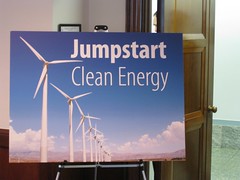Where Are Those “Green” Jobs?

- Image by Third Way via Flickr
During those early days, of the Obama administration, environmentalists believed, they had found the message to carry them to victory. The stage was set, on what promised to be a grueling debate, over energy and climate policy. The topic was, and still is this: At a time of soaring unemployment, (which is still the case), a climate bill, would create thousands, or millions of new “clean energy, or green” jobs. So, where are these jobs? You may have noticed signs, along the road, in your area, stating, where your tax dollars are going. Funny, thing is, the money was spent on the signs, not on fixing the ROADS. So much, for our stimulus dollars at work, but NOT, our people being EMPLOYED!
Climate activists spent 18 months, and millions of dollars, at the drawing board, pushing that message. It was believed that, legislation to reduce the greenhouse gas emissions, was to blame for climate change. So in theory, that would spark investments and create jobs in solar, wind and other alternatives, to fossil fuels. But, those arguments lost out in the Senate. Competing forces — stirred amid, warnings that emissions limits would push electric rates higher, killing jobs, and stunting growth, that depends on cheap oil, coal and natural gas, or dirty fuels.
Activists, along with some economists, and business leaders, NOW say, the current outcome, stands as a stark example of the challenges we face, in reshaping and revitalizing, the United States economy.
The argument that climate legislation, would create jobs,hasn’t gained much traction, in the Senate, or bought about much visible change, in the area of “green” jobs. It has always been, more visible and tangible, to see jobs that “go with” fossil fuels. However, placing more emphasis on, distributed energies, like solar and wind, makes it more difficult to identify jobs, that are visible and tangible, to go with it.
There really are jobs, in the areas of renewable energy, and there certainly will be jobs, in new technologies. It’s just hard to say when, we will see a surge, in the jobs that are related, to this field. It could be said, that
the economic debate over emissions, and climate change, has limited, some of our economy’s industrial growth and backbone, against potential growth engines of the future.
Several business coalitions, endorsed emissions limits – including some major utilities, manufacturers, retailers and even a few oil companies. Of course, fossil-fuel and other business interests fought hard against the bill. Since the BP, oil disaster, it’s NO small wonder. Oil, will never be a dead issue, in this country. There is too much, BIG money tied up in it.
Economic studies, from progressive and free-market think tanks, predict either runaway job creation, or massive economic harm, from a climate bill. Recent government analyses, from the Environmental Protection Agency and Energy Information Administration, showed modest costs from proposed climate legislation, but only a small-scale growth, in wind and solar power. HELLO, the people at the top NOW, will be the ones at the top when renewables are the recognized, and preferred energy source. The big companies, will just switch gears, so they can remain in control of every-one’s wallet!
Environmental groups, have poured tens of millions of dollars, into advertising campaigns, touting clean-energy jobs, a message their polls showed voters responding to. Coal and oil groups, countered with ads warning of higher energy costs. It’s just like SLAM politics, isn’t it?
On Capitol Hill, the fossil-fuel crowd has enjoyed two key advantages. One is influence: Oil and gas companies have combined for nearly $90 million in federal lobbying expenditures, and campaign contributions so far this year, according to records compiled by the Center for Responsive Politics. Wind, solar and other “alternative energy” firms have tallied, only about $16 million. There, you have it. Whoever, supports BIG OIL, wins, right?
Most Senators, have their hand in the oil pot, and therefore, don’t readily support clean energy. Many are on the fence, because they tend to have investments, and key business interests, with utilities or manufacturers, who are opposed to climate action, or policy.
Recently, when asked why climate legislation failed, the president of the American Petroleum Institute, Jack Gerard, told reporters, that “I don’t think the American public is there yet… The entire country, is focused on jobs, and the economy. Anything,that might discourage jobs and employment” will be a tough sell.
Others say, future climate legislation should focus more directly on economics – namely, boosting alternative energy, by taxing fossil fuels, and using the money, to research and scale-up production of lower-cost clean-energy technologies. Now, that sounds like a good idea, but will it happen?
It’s no secret, that here are a lot of costs associated with making a switch to clean energy. The costs won’t go away, or get cheaper, until clean energy technology, gets cheaper. It won’t get cheaper until, it is being used, and in demand. There needs to be, smaller measures, such as tax credits, and other clean-energy incentives, in the wake of the climate bill collapse, that make investing in clean energy attractive, to most consumers.
So, How green is our economy? There, is no precise answer to this question. Our economy is not ” green” enough, and for many it remains bleek.
A green economy, should be promoted, for our future economic development, and growth. In response, to the recent global economic crises, the United Nations Environment Program (UNEP) proposed, the Global Green New Deal, encouraging the world’s governments, to support economic transformation, toward a greener goals.
A “green” economy is characterized by, among other things, primary dependence, on green energy resources. In contrast, many existing economies in most parts of the world, are fueled primarily, by black energy sources (fossil fuels) such as coal, petroleum, and natural gas.
Going green emphasizes, utilizing renewable energy resources (substituting fossil fuels, with alternative energy resources) and practicing energy conservation (aiming to use energy, more efficiently).
Making the shift, from black to green energy resources, means moving away, from resources with high carbon content. More simply stated, making the move from, dirty energy resources to cleaner, “greener” ones.

















